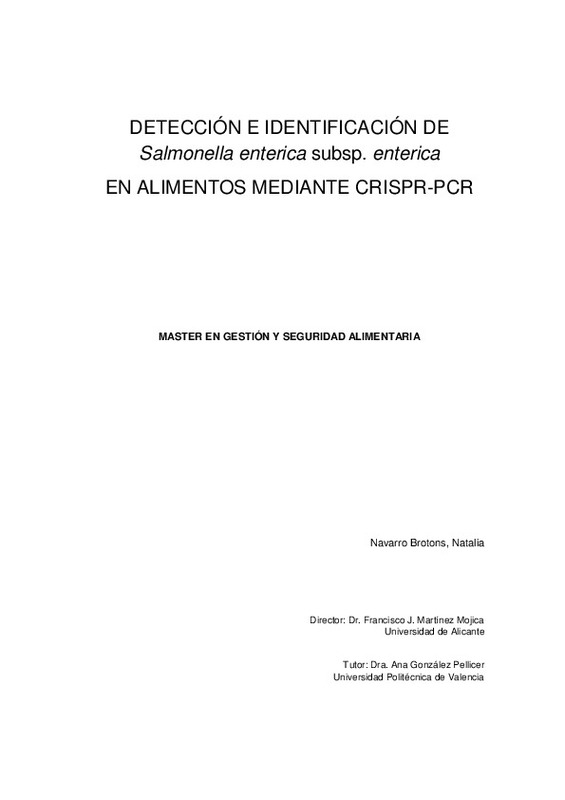|
[ES] La epidemiología de Salmonella enterica se ha estudiado utilizando diversos métodos de tipado molecular entre los que se incluyen PFGE (Pulsed-Field Gel Electrophoresis) y MLST (Multiple-Locus Sequence Typing). El uso ...[+]
[ES] La epidemiología de Salmonella enterica se ha estudiado utilizando diversos métodos de tipado molecular entre los que se incluyen PFGE (Pulsed-Field Gel Electrophoresis) y MLST (Multiple-Locus Sequence Typing). El uso de genes de virulencia y secuencias repetidas CRISPR (Clustered Regularly Interspaced Short Palindromic Repeat) como marcadores genéticos en esquemas MLST ha permitido una mejor diferenciación e identificación de S. enterica subsp. enterica comparado con PFGE. Salmonella spp. posee un único sistema CRISPR/CAS el cual incluye dos agrupaciones de repeticiones, CRISPR1 y CRISPR2.
El objetivo principal de este estudio es poner a punto un método de detección e identificación de Salmonella enterica subsp. enterica en alimentos basado en amplificación por PCR de agrupaciones CRISPR. Para ello han sido analizadas 67 cepas de S. enterica subsp. enterica, incluyendo un mayor porcentaje de aquellos aislados pertenecientes a los dos serotipos principales (Thyphimurium y Enteritidis). La agrupación CRISPR1 se confirmó como una diana adecuada para este fin.
La amplificación por PCR de la agrupación CRISPR1 (CRISPR1-PCR) permitió detectar niveles de S. enterica subsp. enterica inferiores a 10 ufc en muestras de alimento, estableciéndose un procedimiento de análisis mixto, que incluye una etapa inicial de enriquecimientos por cultivo, seguida de la amplificación de dicha agrupación y análisis electroforético del producto obtenido. Como alimento a analizar se utilizó mayonesa por su gran incidencia como vehículo de este tipo de infecciones.
[-]
[EN] The epidemiology of Salmonella enterica has been studied using several molecular subtyping methods, including PFGE (Pulsed-Field Gel Electrophoresis) and MLST (Multiple-Locus Sequence Typing). The use of virulence ...[+]
[EN] The epidemiology of Salmonella enterica has been studied using several molecular subtyping methods, including PFGE (Pulsed-Field Gel Electrophoresis) and MLST (Multiple-Locus Sequence Typing). The use of virulence genes and CRISPR (Clustered Regularly Interspaced Short Palindromic Repeat) as genetic markers in a MLST scheme has allowed a better differentiation and identification of S. enterica subsp. enterica than PFGE approaches. Salmonella spp. has one CRISPR/CAS system including two clusters of repeats, CRISPR1 and CRISPR2.
The main objective of this research is to set up a new method for detection and identification of Salmonella enterica subsp. enterica in food based on PCR amplification of CRISPR clusters. A total of 67 strains of S. enterica subsp. enterica have been analyzed including a higher percentage of isolates belonging to the main serotypes (Thyphimurium and Enteritidis). CRISPR1 was confirmed as a suitable target for this purpose.
PCR amplification of CRISPR1 (CRISPR1-PCR) allowed the detection of S. enterica subsp. enterica at levels under 10 cfu in food samples. Eventually, a mixed-analysis procedure was established, including an initial stage of enrichments by culture, followed by amplification and electrophoretic analysis of the PCR product. Mayonnaise was the food of choice due to its high incidence as a vehicle of this type of infection.
[-]
[CA] L'epidemiologia de Salmonel.la enterica s' ha estudiat utilitzant diversos mètodes de tipat molecular entre els que s'inclouen PFGE (Pulsed-Field Gel Electrophoresis) i MLST (Multiple-Locus Sequence Typing). L'ús de ...[+]
[CA] L'epidemiologia de Salmonel.la enterica s' ha estudiat utilitzant diversos mètodes de tipat molecular entre els que s'inclouen PFGE (Pulsed-Field Gel Electrophoresis) i MLST (Multiple-Locus Sequence Typing). L'ús de gens de virulència i seqüències repetides CRISPR (Clustered Regularly Interspaced Short Palindromic Repeat) com a marcadors genètics en esquemes MLST ha permés una millor diferenciació i identificació de S. enterica subsp. enterica comparat amb PFGE. Salmonel·la spp. posseïx un únic sistema CRISPR/CAS el qual inclou dos agrupacions de repeticions, CRISPR 1 i CRISPR 2. L'objectiu principal d'aquest estudi és posar a punt un mètode de detecció i identificació de Salmonel·la enterica subsp. enterica en aliments basat en amplificació per PCR d'agrupacions CRISPR. Per a això han sigut analitzades 67 soques de S. enterica subsp. enterica , incloent un major percentatge d'aquells aïllats pertanyents als dos serotips principals (Thyphimurium i Enteritidis). L'aprupació CRISPR 1 es va confirmar com una diana adequada per a aquesta fi.
L'amplificació per PCR de l'agrupació CRISPR1 (CRISPR1-PCR) va permetre detectar nivells de S. enterica subsp. enterica inferiors a 10 ufc en mostres d'aliment, establint-se un procediment d'anàlisi mixta, que inclou una etapa inicial d'enriquiments per cultiu, seguida de l'amplificació d' aquesta agrupació i anàlisi electroforètic del producte obtingut. Com a aliment a analitzar es va utilitzar maionesa per la seua gran incidència com a vehicle d'aquest tipus d'infeccions
[-]
|







